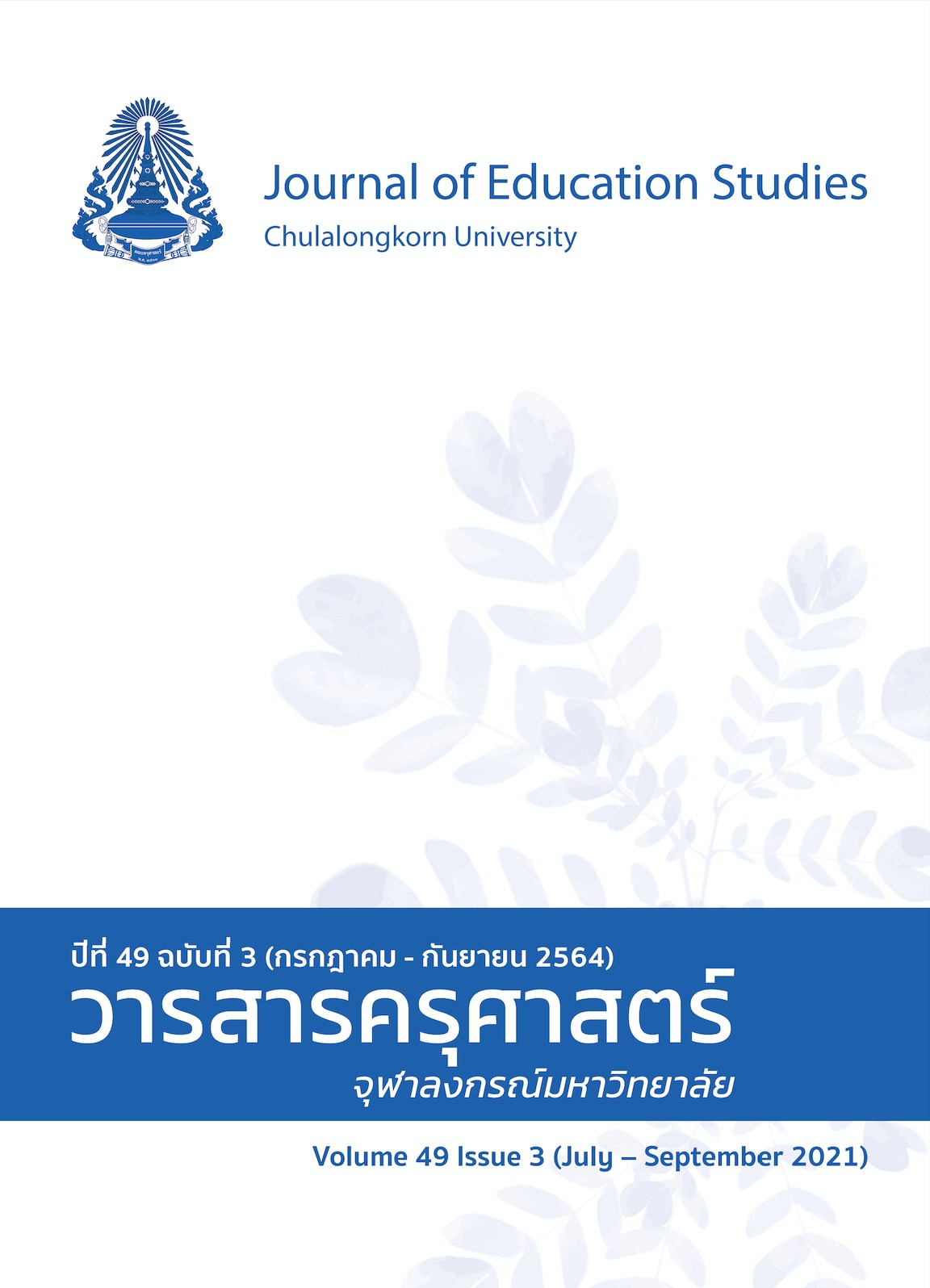Relationship between Hand Dexterity and Writing Speed of Students Grade 4 - 6
DOI:
https://doi.org/10.14456/educu.2021.48Keywords:
hand dexterity, writing speed, studentsAbstract
The purpose of this study was to examine the relationship between hand dexterity and writing speed among students in grades 4 - 6. The participants were 96 students selected by simple random sampling from schools in Muang Chiang Mai. Hand dexterity was tested by the Children Hand Dexterity Test including 4 test items: placing pegs with one hand, placing pegs with two hands, in hand manipulation, and tool use (tongs). Writing speed was measured by using a speed test of Thai alphabet Handwriting Assessment. Data was analyzed by using the Pearson correlation coefficient. The result showed significant correlation between hand dexterity and writing speed (p < 0.05). The moderate correlation coefficients of hand dexterity and writing speed from high to low were as follows: r = -.465 for placing pegs two hand, r = -.348 tool use (tongs), r = -.305 for in hand manipulation, and r = -.202 for placing pegs with one hand.
References
กัญญ์สิริ จันทร์เจริญ. (2548). การกำหนดประชากรและกลุ่มตัวอย่าง. ใน ประกาย จิโรจน์กุล (บก.), การวิจัยทาง
การพยาบาล : แนวคิด หลักการ และวิธีปฏิบัติ (น. 85-114). โครงการสวัสดิการวิชาการ สถาบันพระบรมราชชนก.
นิภา ศรีไพโรจน์. (2531). หลักการวิจัยเบื้องต้น (พิมพ์ครั้งที่ 2). ศึกษาพร.
นันทณี เสถียรศักดิ์พงศ์, ธีรภัทร์ ปัญญานนท์, และ ดาราณี สาสัตย์. (2560). การพัฒนาแบบทดสอบความคล่องแคล่วใน
การทำงานของมือสำหรับนักเรียน. มหาวิทยาลัยเชียงใหม่.
เนตรทราย ทองจำรัส (2553). ความตรงตามเนื้อหาและความเชื่อมั่นแบบวัดซ้ำของแบบประเมินความสามารถด้านการเขียนพยัญชนะไทย. มหาวิทยาลัยเชียงใหม่.
เบญจรัตน์ นุขนาฏ์. (2553). พัฒนาการของนักเรียน 6 – 12 ปี. สถาบันแห่งชาติเพื่อการพัฒนาเด็กและครอบครัว มหาวิทยาลัยมหิดล.
ผกาวรรณ สิทธิวงศ์. (2551). กิจกรรมบำบัดและการส่งเสริมทักษะพื้นฐานการเขียน (ตอนที่ 1). วารสารราชานุกูล, 23(3),
53-57.
ศศิธร สังข์อู๋. (2559). พัฒนาการและความสามารถในการประกอบกิจกรรมการดำเนินชีวิตในวัยเรียน. เอกสารประกอบ
การสอน กระบวนวิชา 513114. มหาวิทยาลัยเชียงใหม่.
อลิษา นันตา. (2560). ความสัมพันธ์ระหว่างความเร็วในการเขียนอักษรไทยและอักษรอังกฤษของนักเรียนชั้นประถมศึกษา
ปีที่ 1 – 3. มหาวิทยาลัยเชียงใหม่.
ภาษาอังกฤษ
Amundson, S. (2005). Prewriting and handwriting skills. In J. Case-Smith (Ed.), Occupational therapy for children (5th ed) (pp. 587-614). Mosby Elsevier.
Bruni, M. (2006). Fine motor skills for children with down syndrome. Woodbine House.
Cohen, J. W. (1988). Statistical power analysis for the behavioral sciences (2nd ed). Lawrence Erlbaum Associates.
Klein, S., Guiltner, V., Sollereder, P., & Cui, Y. (2011). Relationships between fine-motor, visual-motor, and visual perception scores and handwriting legibility and speed. Physical & Occupational Therapy in Pediatrics, 31(1), 103-114. http://doi.org/10.3109/01942 638.2010.541753
Omar, M. T. A., Alghadir, A. H., Zafar, H., & Al Baker, S. (2018). Hand grip strength and dexterity function in children aged 6 - 12 years: A cross-sectional study. Journal of Hand Therapy, 31(1), 93-101.
Sartorio, F., Bravini, E., Vercelli, S., Ferriero, G., Plebani, G., Foti, C., & Franchignoni, F. (2013). The functional dexterity test: Test–retest reliability analysis and up-to date reference norms. Journal of Hand Therapy, 26(1), 62-68.
Simons, J. (2014). Reliability of the detailed assessment of speed of handwriting on flemish children. Pediatric Physical Therapy, 26(3), 318-324. Doi:10.1097/PEP.0000000000000050
Tseng, M. H., & Chow, S. M. K. (2000). Perceptual-motor function of school-age children with slow handwriting speed. American Journal of Occupational Therapy, 54(1), 83–88.
DOI:10.5014/ajot.54.1.83
Downloads
Published
How to Cite
Issue
Section
License

This work is licensed under a Creative Commons Attribution-NonCommercial-NoDerivatives 4.0 International License.




